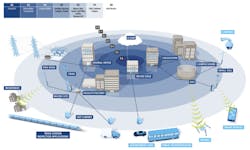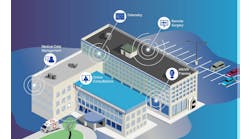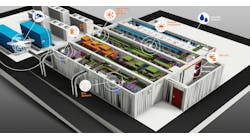Facing the Challenges of Today’s Modern Data Center: Know Your Site – From Hyperscale to Edge
Our world is full of buzz words: 5G, WiFi6, Densification, Datafication, IoT. At the heart of all of this stands the modern data center, which is supported by a dense fiber network, high-density cabling, a hyperscale level of connectivity and low-loss interconnect. All of this is key to transforming our world into one that is all about the data.
It is said that “humans are on a quest to digitize the world,” and data has become the lifeblood of our society and our lives. Data consumption is growing at an exponential rate. It’s estimated that cellular data usage will eclipse 77 exabytes per month by 2022, and by 2025, the number of connected devices will exceed 150 billion. Additionally, the explosion of fiber consumption has further demonstrated the need for modern data centers. Driven by the deployment of symmetrical gigabit broadband, demand for fiber network deployment is growing globally since it is the only medium that can provide equal upload and download speeds, which is critical to enabling 5G (and beyond) wireless technology. Annual U.S. investment in fiber-to-the-home (FTTH) is expected to exceed $12 billion by 2025, and just in the last year, the North American fiber cable consumption is estimated to have grown by over 15%.
These past couple of years have changed the way we approach life, work and everyday activities. As more aspects of our lives shift online, new applications begin to emerge. These emerging applications not only include work-from-home, eLearning and telehealth – all of which are enabled by optical fiber – but also include more advanced applications such as autonomous cars, remote surgeries and drone deliveries of medicines, groceries or packages. The Federal Communications Commission just recently granted Amazon three regional licenses to begin piloting, no pun intended, 5G mmWave-enabled drone deliveries. All of these applications require both high data rates and ultra-low latency, meaning that data centers are needed closer and closer to the edge.
To put in perspective, latency at the central cloud data center is over 100 ms, and latency is around 20 ms at the network edge data center. These measurements are not sufficient for tomorrow’s transformational applications where a split second can make a difference between life and death. However, moving data centers and computing toward the very edge, where latency is less than 10 ms, allows us to get to a reasonable latency for these life-critical applications.
We are entering a new era, enabled by technologies such as 5G and the modern data center at a hyperscale level and at the edge. As data rates and fiber consumption continue to rise, a vast infrastructure, composed of both wireless mobility and fixed wireless access, is necessary to enable traditional and monumental opportunities for those installing the networks as well as the society that is making use of them. Modern data centers are the heart of this emerging reality. The keys to successfully building modern data center are founded not only in the optical infrastructure you choose but also in the processes and tools you use to ensure successful deployments. Knowing your space is the first step in facing the challenges of today’s modern data center.
With increasing data rates and fiber consumption, network operators must build their data centers to accommodate this exponential growth. It’s all about getting the most value out of each square inch of floor space, which requires a focus on density. In other words, how many connections can you fit in one square inch of space, how much bandwidth can you enable and how much revenue can you achieve in one square inch of space? Utilizing products and solutions that enable a high level of density is key. Today’s flexible ribbon cables provide a transformation level of density. Their small size allows operators to maximize their space, thus enabling the massive data center growth that is needed.
Data center operators must also install specialized connectivity to manage this influx of fiber. After all, connectivity is where it all comes together (or all falls apart). Installing hyperscale-level patch and splice enclosures and utilizing field-installable connectors is necessary to successfully integrate the mass amount of cable into the architecture.
It’s also important that operators design for the future. Building expandability, flexibility and accessibility into data centers helps prepare for future technological demands. As technology advances, the underlying infrastructure of the data center must adapt as well. Build your site with these three characteristics in mind – the infrastructure must have the expandability to accommodate the increased traffic and bandwidth needs, the flexibility to manage this expansion and the accessibility to implement these changes in the field both today and in the future.
Manja Thessin is Enterprise Market Manager at AFL. Seán Adam is Vice President of Market Strategy and Innovation at AFL, an international manufacturer providing end-to-end solutions to the energy, service provider, enterprise, hyperscale and industrial markets. Contact AFL to learn more about their solutions.







